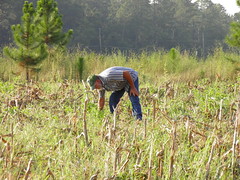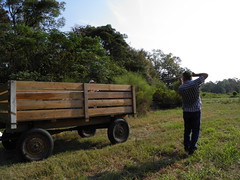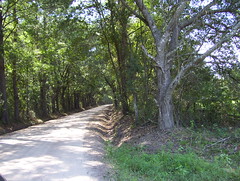 Who’s that in the field?
Why it’s that Terry Davis,
collecting corn ears that his combine missed!
Who’s that in the field?
Why it’s that Terry Davis,
collecting corn ears that his combine missed!
 Some assembly required for the trailer.
Some assembly required for the trailer.
 Here’s what we want to pick: ears of corn on standing stalks.
Here’s what we want to pick: ears of corn on standing stalks.
Here we go: Continue reading
 Who’s that in the field?
Why it’s that Terry Davis,
collecting corn ears that his combine missed!
Who’s that in the field?
Why it’s that Terry Davis,
collecting corn ears that his combine missed!
 Some assembly required for the trailer.
Some assembly required for the trailer.
 Here’s what we want to pick: ears of corn on standing stalks.
Here’s what we want to pick: ears of corn on standing stalks.
Here we go: Continue reading
 Ever wonder why all the trees and shrubs die under the power lines? Company workers spray toxic chemicals on them.
Driving on GA 122 between Pavo and Barney and saw some electric company spraying going on. This fellow didn’t seem happy I was recording:
Ever wonder why all the trees and shrubs die under the power lines? Company workers spray toxic chemicals on them.
Driving on GA 122 between Pavo and Barney and saw some electric company spraying going on. This fellow didn’t seem happy I was recording:
Note that this worker is unprotected from this poison. No eye covering, no mask. Spraying is a shame in many ways.
Why do they do this? Continue reading
“from a traffic safety perspective, the modern commercial arterial is a perfect storm of bad planning and design. These roads are designed to support high operating speeds, making it difficult for drivers to stop quickly to avoid a crash, and the presence of commercial and retail uses on these roads means that drivers will routinely need to stop quickly in order to avoid crashing into pedestrians, bicyclists, and especially vehicles turning in and out of driveways.”The 2006 article, Safe Urban Form: Revisiting the Relationship Between Community Design and Traffic Safety, by Eric Dumbaugh and Robert Rae, notes: Continue reading
 Beta New Urban Network reported 1 September 2006 that
Research: trees make streets safer, not deadlier:
Beta New Urban Network reported 1 September 2006 that
Research: trees make streets safer, not deadlier:
Proposals for planting rows of trees along the roads — a traditional technique for shaping pleasing public spaces — are often opposed by transportation engineers, who contend that a wide travel corridor, free of obstacles, is needed to protect the lives of errant motorists.The study asks a key question: Continue readingIncreasingly, however, the engineers’ beliefs about safety are being subjected to empirical study and are being found incorrect. Eric Dumbaugh, an assistant professor of transportation at Texas A&M, threw down the gauntlet with a long, carefully argued article, ”Safe Streets, Livable Streets,” in the Summer 2005 issue of the Journal of the American Planning Association. A follow-up article by Dumbaugh, in the 2006 edition of Transportation Research Record, will present further evidence that safe urban roadsides are not what the traffic-engineering establishment thinks they are.
Though engineers generally assert that wide clear areas safeguard motorists who run off the roads, Dumbaugh looked at accident records and found that, on the contrary, wide-open corridors encourage motorists to speed, bringing on more crashes. By contrast, tree-lined roadways cause motorists to slow down and drive more carefully, Dumbaugh says.
Dumbaugh examined crash statistics and found that tree-lined streets experience fewer accidents than do “forgiving roadsides” — those that have been kept free of large, inflexible objects. He points to “a growing body of evidence suggesting that the inclusion of trees and other streetscape features in the roadside environment may actually reduce crashes and injuries on urban roadways.”
 Jeremy Scahill write in the Nation about
Blackwater’s Black Ops:
Jeremy Scahill write in the Nation about
Blackwater’s Black Ops:
Blackwater, through Total Intelligence, sought to become the “intel arm” of Monsanto, offering to provide operatives to infiltrate activist groups organizing against the multinational biotech firm.What’s the connection between Total Intelligence Solutions and Blackwater, the company famous for its activities as a military contractor in Iraq, and now known as Xe? According to the story, both are owned by Blackwater’s founder, Eric Prince, pictured to the right.
-jsq
García is the large man sitting in front of the flag. The Monsanto rep. is the short man sitting to García’s left.
It’s not clear when this meeting took place, but it may have been the one referred to in this 11 Oct 2007 story, which says: Continue reading
More pictures in the flickr set. Pictures by Gretchen Quarterman, Lowndes County, Georgia, 4 Sep 2010.
-jsq